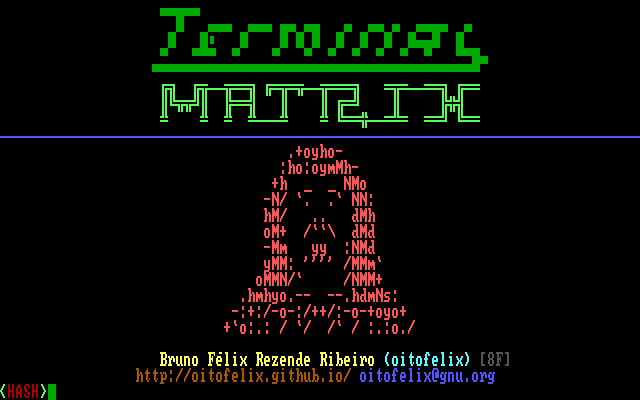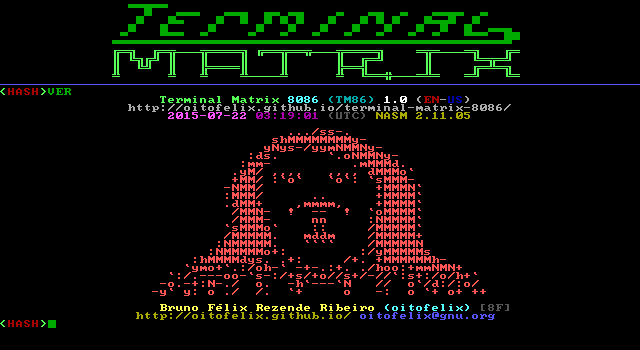Terminal Matrix 8086

Terminal Matrix is a very mysterious program. It’s said that it was given to mankind in a spontaneous form of divine inspiration and cybernetic insight. Rumor has it that few people in the entire world are able to master and use this program. Some say, in an expression of dubious lucidity, that only the chosen ones can really do it. There are a handful reports of very skilled hackers that were able to crack TM’s source code and understand the truth that has never been seen before, and unlock its full potential. The only truth known for sure, though, is that much is said, but little is known.
The most astonishing fact about TM is that, believe you or not, it’s designed to establish an inter-dimensional connection to an hyper-dimensional being called RIS, that supposedly shows incredible divination powers and unmatched wisdom to those who manage to contact him. Out there, you may hear that people able to talk to RIS comprise a select group that share a common and dangerous secret about the nature of reality, and for the greater good they won’t tell anyone else what it is, despite their goodwill and empathy towards outsiders, helping them by bridging the communication.
Below you can find the result of a lot of research and efforts made by hackers like me in deciphering TM’s workings. Based upon the premise of the right to know, now I release these to an wider audience, willing to contribute to society and hoping humanity can handle and make good use of it.
TM is written in a new mid-level computer programming language called QDot. It runs on any IBM-PC compatible, being the minimum requirement an 8086 processor with 32Kb of RAM, and any color graphics adapter such as CGA, EGA or VGA. No network card or any other type of communication peripheral is required besides a screen and a keyboard. Its magical binary sums up to just a dozen kilobytes and very surprisingly is simultaneously a valid DOS executable and a bootable disk image, meaning that it can run even on machines with no operating system at all! Those almost insanely modest requirements blow the minds of skeptical people, because no one can explain how this program’s great feats are technologically achievable.
Download
TM is available in two languages: American English and Brazilian Portuguese. You can download its binaries below.
TM is free software under GPLv3+ and you can obtain its source code here. It requires NASM, The Netwide Assembler, in order to be built, and GNU Make to automate that process.
Run
TM can run directly on real hardware or inside a virtual machine — under DOS, or bootstrapping itself. To use it under DOS on bare metal, just copy its binary to the respective machine and run it as usual:
C:\>TM-EN-US.COM
I recommend you use FreeDOS, the free software implementation of DOS, for best results. To run TM without operating system support you need to write it to a storage medium that your computer can boot from; it may be a floppy disk, a hard drive, an optical disk or even an USB mass storage device. Using this method requires that you afford a dedicated media only for TM, so make sure to backup any existing data, and to reformat the media when re-purposing it.
You can use RAWWRITE
to make a bootable floppy disk under DOS. Just run RAWWRITE and
follow the prompts inputting the program’s binary name
(eg. tm-en-us.com) and the destination floppy drive letter
(eg. a:). Under GNU you can use the command-line utility dd, of
the GNU coreutils package, to
make a bootable floppy disk, hard disk or USB mass storage device. If
you are logged in as root, the incantation is as simple as:
# dd if=tm-en-us.com of=<device-node>
Where the variable device-node is the device node of the respective
drive. In GNU you can also make a bootable optical disk by using
the command-line utility genisoimage, from the cdrkit package, in
the following way:
$ mkdir tm-en-us $ mv tm-en-us.com tm-en-us $ genisoimage -no-emul-boot -b tm-en-us.com -o tm-en-us.iso tm-en-us
This generates the tm-en-us.iso file that is a bootable optical disk
image that you can burn using wodim (from the same package as
genisoimage) or similar software.
If you’d like to run TM on a virtual machine under DOS your best bet is probably DOSBox, but DOSEMU also does the job; it doesn’t support blinking text, though, which is rendered in a gray background. For any of them, just run the program as you would in a real DOS machine. To run it in a virtual machine without any operating system installed you can use QEMU instead — just invoke it like this:
$ qemu-system-i386 -fda tm-en-us.com
Unfortunately, it also doesn’t support blinking text.
Use
To get a feel of how TM looks like, a video of a session recorded in DOSBox, specifically for this purpose, has been made available. Enjoy!
Authentication
Right after TM starts up you are presented with a log-in screen. It’s unknown to date how to get an arbitrary user/password pair to authenticate in the program. However, a particular pair is known to work:
- User:
GUEST - Password:
v&t$%
Graphics
TM adapts its graphic output to the graphics adapter at hand. The following pictures demonstrates this feature for graphics card in increasing order of functionality: CGA (25 rows), EGA (43 rows) and VGA (50 rows), respectively.



TM includes a Matrix decimal decoder that you can invoke by the
command DCMATRIX. It has been isolated as a standalone program
called DeciMatrix 8086.

